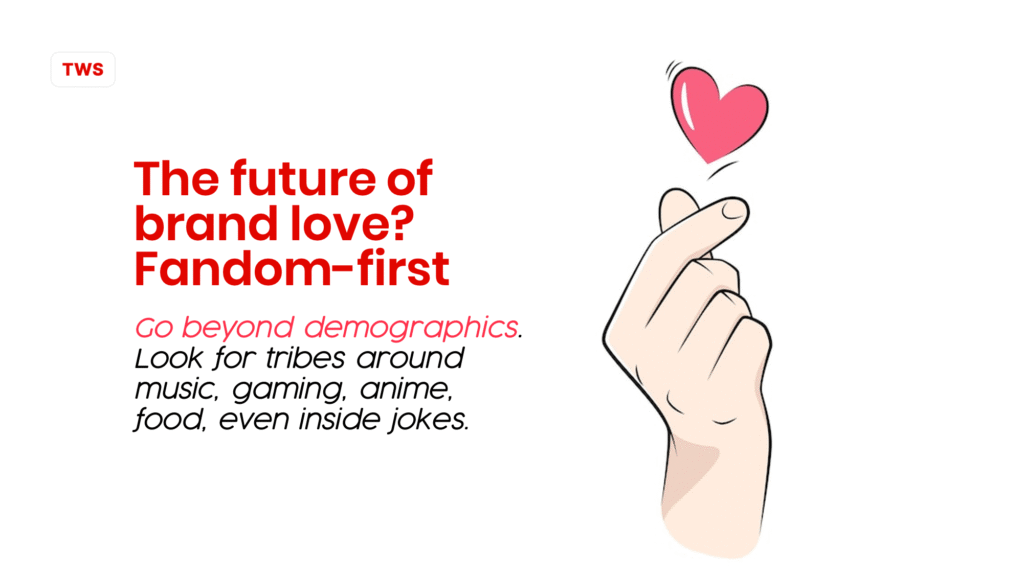
The future of brand love? Fandom-first, not hashtag-heavy
In today’s marketing economy, culture moves faster than brand calendars. A TikTok meme can peak and die in 72 hours. A creator’s inside joke can spark a global remix culture overnight. For brands, the challenge isn’t just to “join the conversation”—it’s to actually fuel culture in real time, at the velocity of fandoms.
The problem is that most brands still play the wrong game. They chase hashtags, not humans. They buy trending soundbites, not subculture equity. They brief for a viral stunt, instead of designing for community behavior.
But in 2025, the brands that win aren’t the ones shouting the loudest into the feed. They’re the ones who build with fandoms—deep, participatory communities of people who create, remix, and live their identities together online.
Why hashtags don’t build culture
A hashtag is a moment. A fandom is a movement.
Take the average brand campaign: it rides on a seasonal hashtag (#SummerSale, #NewYearNewMe) and invests in a burst of media. Sure, it spikes awareness. But it doesn’t last, because hashtags aren’t owned by people. They’re just empty rooms brands ask people to walk into.
A fandom, by contrast, is alive whether a brand touches it or not. K-pop stans don’t need permission to organize fancams, fan art, or flash mobs. Gamers don’t wait for publishers to tell them how to meme a character skin. Swifties don’t need Taylor Swift in the room to design friendship bracelets for Eras Tour strangers.
Brands who only chase hashtags are spectators. Brands who embed in fandoms become co-participants in culture.
Culture at speed = co-creation
The old advertising model was broadcast: a brand defines the idea, pays to amplify it, and consumers react. The fandom model is collaborative: a brand gives fans building blocks, and fans run with it.
Think about Changi Airport’s partnership with Swifties in Singapore. Instead of a standard “airport promo,” they leaned into the Swiftie fan economy. They created Swiftie-coded experiences inside the airport—photo booths, meet-ups, and exclusive merch—that turned the transit hub into part of the fandom ritual. Fans didn’t just consume; they produced content, TikToks, Reels, and micro-memories that extended Changi’s brand into global fan feeds.
That’s culture at speed. Not reactive. Not corporate. Just fuel for a fire that was already burning.
What fandoms give brands
Fandoms aren’t just fun—they’re strategic growth engines. They offer three advantages traditional advertising can’t match:
- Networked Amplification
Fans share faster than media dollars can buy. Every meme, every remix, every TikTok is distribution without the CPM. - Cultural Legitimacy
Brands can’t fake cool, but fandoms can lend it. When fans remix a brand asset authentically, the brand earns insider status instead of looking like a crasher. - Built-in Loyalty
A hashtag lasts a week. A fandom lasts decades. Just ask Marvel or Manchester United. Once you’re embedded, you don’t just get attention—you get recurring love.
Anatomy of fandom-first marketing
To build with fandoms, you don’t need a stadium or a superstar. You need to design for participatory behavior. Here’s the playbook:
- Spot the micro-cultures
Go beyond demographics. Look for tribes around music, gaming, anime, food, even inside jokes. In Bangladesh, think: mobile gaming clans, cafe music circles, or Dhallywood meme communities. - Give tools, not taglines
Instead of pushing a hashtag, create remixable content (templates, sounds, AR filters, stickers). Think of it as Lego bricks for fans. - Collaborate with fan-creators
Every fandom has its own “native leaders”: cosplayers, cover artists, meme pages. Co-create with them instead of hiring generic influencers. - Reward the contribution, not the click
Don’t just measure engagement rates. Reward fans who create and spread culture. Nike doesn’t just count likes—it gives sneakerheads early drops. - Move at fan speed, not brand speed
Forget 6-month approval calendars. Culture shifts weekly. Brands need agile teams who can greenlight fast experiments.
Global case studies to steal from
- Duolingo & K-pop stans: The green owl isn’t just a mascot anymore—it’s an honorary stan account. By making inside jokes about K-pop idols, Duolingo turned into a fandom meme machine.
- LEGO & AFOLs (Adult Fans of LEGO): LEGO didn’t invent fan-built sets—fans did. LEGO legitimized it with LEGO Ideas, turning fan passion into commercial product lines.
- Liquid Death & metalheads: The water brand didn’t just brand like a soft drink; it built a whole subculture around metal, horror, and absurd humor, turning fans into disciples.
So, what should brands do tomorrow?
- Audit fandoms, not hashtags → Identify where your audience already belongs.
- Shift budgets from media buys to fan tools → Invest in the things fans will pick up and spread.
- Build internal “fan teams” → Create cross-functional groups who monitor and respond at the velocity of culture.
- Let go of control → Culture at speed means handing the steering wheel to communities.
The final word
The future of brand building is about becoming part of the fan canon. The brands that will survive the algorithmic churn of 2025 aren’t the ones with the catchiest hashtags. They’re the ones that respect fandoms as the real engines of culture.
Which fandom are we building with?